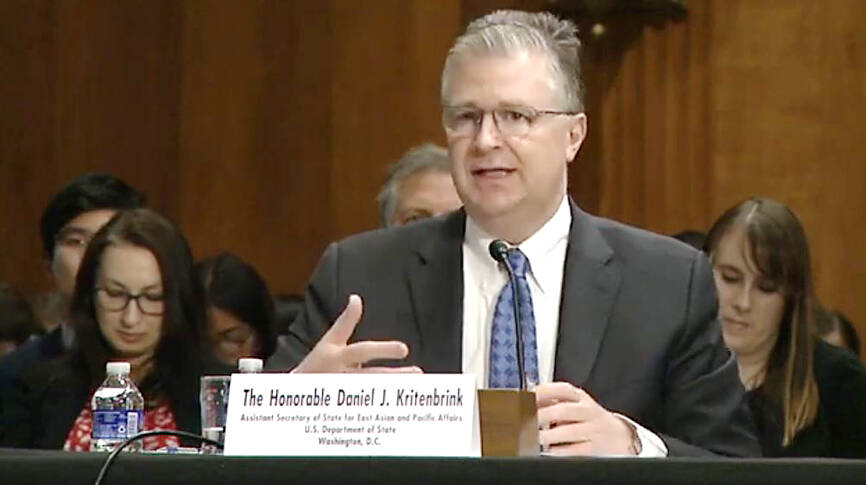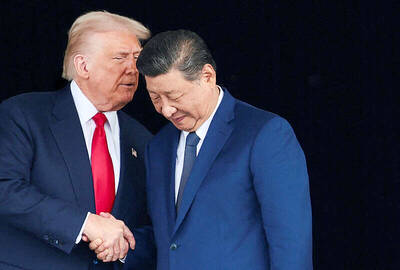The US has warned Taiwan’s diplomatic allies in the Pacific to be “cautious and careful” in dealing with China, US Assistant Secretary of State for East Asian and Pacific Affairs Daniel Kritenbrink told US senators on Thursday, adding that Washington is working closely with them to maintain stability and prosperity in the region, despite Beijing’s influence.
The US Senate Committee on Foreign Relations held a hearing on “US Strategy in the Pacific Islands Region” on to discuss effective solutions to “push back” against Beijing’s influence, said US Senator Jim Risch, a ranking member of the committee.
China is seeking “to erode longstanding US partnerships in the region,” such as proposing untransparent infrastructure projects and pressuring Taiwan’s diplomatic allies to switch ties to Beijing, US Assistant Secretary of Defense for Indo-Pacific Security Affairs Ely Ratner said.

Photo: screen grab from US Senator Jim Risch’s YouTube channel
The Pacific islands are vulnerable to influence from China, which “has moved aggressively to assert itself” in the region, Kritenbrink said.
The US Congress last week renewed the Compacts of Free Association, providing Micronesia, the Marshall Islands and Palau with assistance on the economy, defense and other fields.
The assistance provided under the compacts “are key to maintaining the stability and prosperity of our closest Pacific island partners, and to safeguarding our shared long-term defense and strategic interests in the region,” he said.
Three Pacific island nations have switched recognition from Taiwan to China in the past six years: the Solomon Islands and Kiribati in 2019, and Narau earlier this year.
Beijing lured away Taiwan’s allies with economic inducements, and “misused and misinterpreted” UN General Assembly Resolution 2758, Kritenbrink said.
He called on US allies “to be careful and clear-eyed about entering these arrangements with China.”
“China will often make many promises that remain unfulfilled, and that can have negative consequences,” he said.
The US is working “very carefully and closely” with Taiwan’s three remaining allies in the Pacific — Palau, the Marshall Islands and Tuvalu — “to close off any opportunities that China could exploit,” he added.
There is precedent for nations to switch recognition back and forth between Beijing and Taipei, Kritenbrink said, adding that the US is not aiming to force nations to choose their diplomatic allies, but to ensure their “ability to make their own sovereign decisions, free from coercion.”
The US urges nations “to be cautious and careful given the track record of the PRC” while considering switching ties, he said, referring to the People’s Republic of China.
To counter China’s expansion in the Pacific, the US has to “be present [and] to be active in all of these countries,” Kritenbrink said.
Following the opening of new embassies in the Solomon Islands and in Tonga, the US is soon to open another in Vanuatu and is seeking parliamentary approval for the establishment of an embassy in Kiribati, he said.
In Taipei, the Ministry of Foreign Affairs yesterday thanked US officials for voicing concern over Chinese coercion and encouraged other nations to do the same.

CALL FOR SUPPORT: President William Lai called on lawmakers across party lines to ensure the livelihood of Taiwanese and that national security is protected President William Lai (賴清德) yesterday called for bipartisan support for Taiwan’s investment in self-defense capabilities at the christening and launch of two coast guard vessels at CSBC Corp, Taiwan’s (台灣國際造船) shipyard in Kaohsiung. The Taipei (台北) is the fourth and final ship of the Chiayi-class offshore patrol vessels, and the Siraya (西拉雅) is the Coast Guard Administration’s (CGA) first-ever ocean patrol vessel, the government said. The Taipei is the fourth and final ship of the Chiayi-class offshore patrol vessels with a displacement of about 4,000 tonnes, Lai said. This ship class was ordered as a result of former president Tsai Ing-wen’s (蔡英文) 2018

‘SECRETS’: While saying China would not attack during his presidency, Donald Trump declined to say how Washington would respond if Beijing were to take military action US President Donald Trump said that China would not take military action against Taiwan while he is president, as the Chinese leaders “know the consequences.” Trump made the statement during an interview on CBS’ 60 Minutes program that aired on Sunday, a few days after his meeting with Chinese President Xi Jinping (習近平) in South Korea. “He [Xi] has openly said, and his people have openly said at meetings, ‘we would never do anything while President Trump is president,’ because they know the consequences,” Trump said in the interview. However, he repeatedly declined to say exactly how Washington would respond in

WARFARE: All sectors of society should recognize, unite, and collectively resist and condemn Beijing’s cross-border suppression, MAC Minister Chiu Chui-cheng said The number of Taiwanese detained because of legal affairs by Chinese authorities has tripled this year, as Beijing intensified its intimidation and division of Taiwanese by combining lawfare and cognitive warfare, the Mainland Affairs Council (MAC) said yesterday. MAC Minister Chiu Chui-cheng (邱垂正) made the statement in response to questions by Democratic Progressive Party (DPP) Legislator Puma Shen (沈柏洋) about the government’s response to counter Chinese public opinion warfare, lawfare and psychological warfare. Shen said he is also being investigated by China for promoting “Taiwanese independence.” He was referring to a report published on Tuesday last week by China’s state-run Xinhua news agency,

‘ADDITIONAL CONDITION’: Taiwan will work with like-minded countries to protect its right to participate in next year’s meeting, the foreign ministry said The US will “continue to press China for security arrangements and protocols that safeguard all participants when attending APEC meetings in China,” a US Department of State spokesperson said yesterday, after Beijing suggested that members must adhere to its “one China principle” to participate. “The United States insists on the full and equal participation of all APEC member economies — including Taiwan — consistent with APEC’s guidelines, rules and established practice, as affirmed by China in its offer to host in 2026,” the unnamed spokesperson said in response to media queries about China putting a “one China” principle condition on Taiwan’s